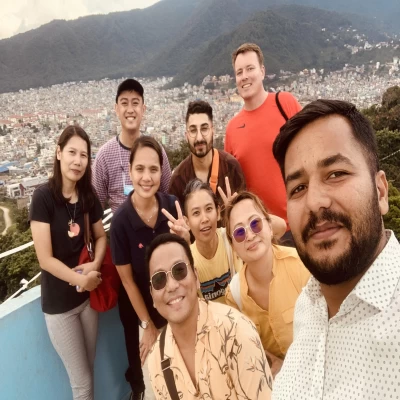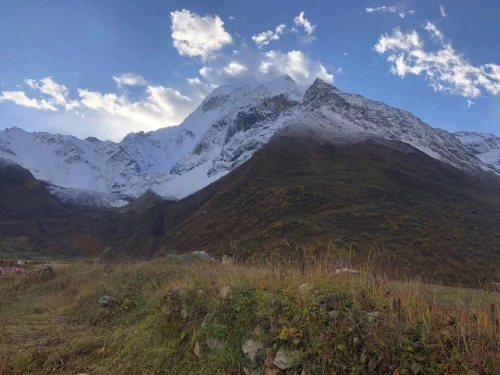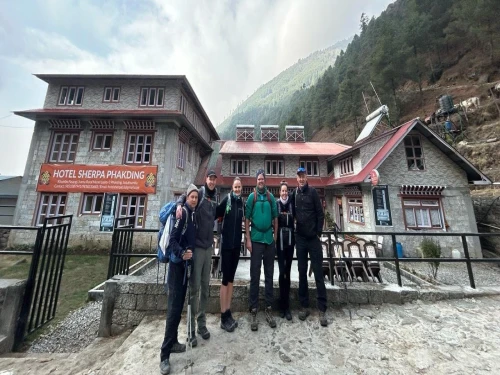
Manaslu region offers an astral experience of adventure, culture, and natural beauty. Altitude varies greatly, as do the flora and fauna types in Manaslu, presenting a vivid picture of life in a diverse ecosystem. Wouldn't it be fun for trekkers to learn about peculiar wildlife and plants and have their tiring trek turned into an enriching nature experience?
With details on some of the region's most important species and ecological features, this blog aims to provide both novice and experienced hikers with an overview of the captivating natural world of Manaslu.
Manaslu Circuit Trekking is widely considered to be a hidden jewel of the Nepalese high-altitude Adventure trekking. Some of its charm comes from comparatively indifferent wildlife in combination with the traffic of Everest or Annapurna courses. The panache of this region is created with an enormous change in elevation, beginning from lush subtropical valleys beneath alpine meadows and icy peaks higher up, hence allowing an eclectic presence of exquisitely different flora and fauna.
An experience in graceful rhododendron forests or spotting snow-clad summits far away results in dancing and trekking through an extremely matrix-like life sculpted through the course of ages by nature and culture. Walking across such a matrix turns every bird call, splash of color from a few flowers, or distant silhouette of an animal into something personally dear to any trekker.
This blog will show you all the best spots inside the Manaslu Conservation Area, including gorgeous alpine meadows and healing herbs, with amazing wildlife such as the Himalayan tahr, snow leopard, and colorful birds. Also, the watchful eye so forging and stepping, conserving and supporting trekking in the placid valley, so that this special valley continues to be alive for the coming years. Whether gearing up for the first trek or just curious about the Himalayan nature, the guide shall give life to Manaslu's wild heart.
About the Manaslu Conservation Area
Manaslu Conservation Area (MCA) is located in the Gorkha district. It encompasses an area of around 1,663 square kilometers and has been established as a preserve for conservation. From its beginning in 1998, it has ranged from the green valleys at just 600 meters above sea level up to the freezing heights of Mount Manaslu at 8,163 meters. This extreme elevation range implies the journey goes from relaxing and lush rhododendron and fern forests through snow-covered peaks to a landscape of rock and ice, offering the fulfillment of a completely fresh trekking experience each day.
Since the Manaslu Conservation Area (MCA) crosses several climatic and habitat zones, it includes a diversity of life forms. Scientists have discovered more than 2,000 species of plants and about 110 species of mammals and birds in this area. At the lower parts, you might see wild orchids and alpine flowers. Further up, you are more likely to see different wildlife as red pandas and Himalayan tahr. Some of these plants and animals are found only in this portion of the Himalaya, turning Manaslu into something of a natural storehouse.
The conservation of the wildlife and plant life of Manaslu is an ongoing and big effort. The local people, park staff, and conservation NGOS keep working together to restrict entry, control camping, and run awareness programs for locals and trekkers as well. When purchasing a trekking permit, you are helping to conserve the park. Your active contribution in protecting this jewel park for every future generation will be in following the regulations of the park about staying on designated trails, cleaning up after yourselves, and showing respect to the wildlife.
Importance of Biodiversity in Manaslu
- The biodiversity of Manaslu keeps nature in balance.
- To protect some of the rare and threatened animals, like snow leopards and red pandas.
- Good biodiversity thus ensures healthy air and water quality in the area.
- It preserves soil and prevents landslides in mountain areas.
- The local people rely on many types of flora for food, medicines, and fuel.
- A diverse ecosystem attracts nature lovers, researchers, and trekkers, thus promoting ecotourism.
- This maintains natural cycles and thus influences climatic conditions.
- Plant life in Manaslu comprises several types of plants that have applications in ethnomedicine.
- Animals, birds, insects, and plants are interdependent for their survival.
- The future of both people and nature will be secured by protecting the biodiversity of Manaslu.
Flora of the Manaslu Region
In the Manaslu area, you can witness an abundance of floral types, especially in those alpine meadows spread across altitudes above 3,000 m. The Manaslu mountain greenery displays a stunning display of colors with wildflowers that freely bloom around the months of spring and early summer. Trekkers would witness flowering plants of all varieties, from the mighty rhododendrons to primulas, gentians, and potentillas. These are plants that have adapted to a cold, windy, and difficult environment in terms of soil in the high Himalayas and have created a wonderfully unique and delicate ecosystem. This explosive coral of colors against the harsh mountain backdrop is quite a natural treat on the Manaslu trekking trail.
Endemic flowering plants of Nepal, suitable to this region, are an additional floristic richness, which means that these plants are uniquely restricted to this area or a very few other Himalayan areas. Several of these kinds serve to maintain the ecological balance as they supply food and shelter to various insects and animals. For example, rhododendrons are Nepal's national flower, and they occur in more than 30 varieties in the Himalayas alone, many of which could be seen in Manaslu. These indigenous plants equally play essential roles in the traditional and cultural landscape of the local communities, where they learn of these plants in festivals and local folklore. To trek enthusiasts, identification of these flowers will surely add a layer of length and appreciation to the scenic trails.
While Manaslu may have a fame of its own for being beautiful and sublime, it is also gifted with an abundance of medicinal plants that local people have used through the centuries to treat numerous ailments. Herbs like yarsagumba (Ophiocordyceps sinensis), popularly known as Himalayan Viagra, and aconite are very much sought by traditional healers.
They grow naturally all along the trekking trails, especially in the alpine and subalpine zones. Information regarding these herbs has been passed on from old to young, preserving their value in traditional Himalayan medicine. Trekkers, be cautious when collecting specimens of plants, since many medicinal herbs are protected, and it is crucial not to harm the environment while harvesting to preserve these resources for the future.
Fauna of the Manaslu Region
The area around Manaslu isn't just mountains and routes. It's also home to an amazing range of animals. Trekkers and people who love nature find it exciting to see animals in their natural habitat.
The Himalayan tahr is one of the most popular animals in this area. A mountain goat called the Himalayan tahr has thick, reddish-brown hair and curved horns on its head. People often spot these animals grazing on rocky slopes or effortlessly walking on top of rocks, particularly in the early morning or late evening. Perhaps you'll be able to see them, even though they are shy.
From an ecological point of view, tahr are very important because they help keep plant life in order by grazing, and they are also food for bigger animals that eat them.
The snow leopard, on the other hand, is one of the most elusive and hardest to find big cats in the world. People value the snow leopard because it is so rare and hard to find.
Snow leopards have a unique adaptation to living at high elevations and on rough terrain. Their thick fur and natural ability to fit in with their environment help them do this. Even though most trekkers don't see snow leopards very often, just knowing that they are there adds an extra attraction to a normal trip to Manaslu. The consortium is working to stop the shooting and protect their homes.
The Manaslu area is a place birdwatchers may find fascinating. There are over 110 species in and around the basin, including the national bird of Nepal, which is the colorful Himalayan Monal, Blood Pheasant, Finches, and Warblers. The lower forests have loads of beautiful birds flying around. Meanwhile, as you go higher, you will find hardy bird species that can live in cold, open expanses. Birdwatching in the spring and autumn, as there are various migratory and native species during these times.
Tips for Trekking and Observing Flora and Fauna in Manaslu
Trekking in the Manaslu area is a haven for plant and wildlife lovers. That means the explorer must acknowledge the land, remain patient, and hold a strong affection for nature.
Furthermore, the wildlife encounter is further enhanced when trekkers maintain silence, plan their trip for the right season, and find the guidance of very knowledgeable local people, who will also help preserve this very delicate environment in the Himalayas.
Here are the basic tips while trekking to Manaslu
- Move slowly and quietly to avoid the animal listening to or watching you.
- Random noises or quick actions will scare them away, so avoid making them.
- Keep a distance while observing animals and birds, or watch through binoculars.
- Spend all of your time in nature, paying attention to things like bird cries and leaves. This will make the experience more enjoyable for you.
- In the spring (March to May) and fall (September to November), the trails offer some of the most spectacular views.
- In the spring, flowers bloom, and in the fall, the skies are clear and the animals are lively.
- Don't go trekking in the winter since it's too cold and you won't see any animals.
- Choose a local guide who knows a lot about plants and animals.
- Guides will assist you in learning how to recognize footprints, find rare species, and follow excellent hiking rules.
- Stay on the path at all times to keep the area clean and undisturbed.
- To conserve the Manaslu ecosystem, let's everyone stand up and obey the Leave No Trace rules.
- If you treat this natural beauty with respect when you hike, it will be around for future years.
Conclusion
Manaslu’s spectacular natural beauty is much further than its towering peaks and rugged trails. Its flora and fauna produce a living geography that enriches every touring step with wonder and discovery. From the vibrant alpine meadows shops to the fugitive Himalayan tahr and snow leopard, and from medicinal sauces cherished by locals to various catcalls darting through ancient timbers, Manaslu’s biodiversity is a treasure waiting to be explored. Understanding and appreciating these living prodigies adds depth and joy to your touring adventure.
As you plan your trip, flash back that this pristine terrain depends on aware callers who admire and protect its fragile ecosystems. Take time to observe still, follow conservation guidelines, and support original sweats to save this inconceivable region. The recollections you make then will be shaped not only by the mountains but also by the rich shade of life that thrives in Manaslu’s nature. So, embark on your journey with curiosity and care, and let the natural world of Manaslu inspire and allure your soul.
FAQS
Q1: What kind of wildlife can you see in Manaslu?
Himalayan Tahr, Snow Leopards, Red Pandas, Musk Deer, and birds such as the Himalayan Monal and Blood Pheasant can be seen.
Q2: When can I witness rhododendrons in Manaslu?
Spring, particularly April and May, is when rhododendrons bloom all along the trekking routes in vibrant colors.
Q3: Do we get to see the Snow Leopard on the Manaslu trek?
The snow leopards are very secretive and hardly sighted, but their presence in the region is confirmed.
Q4: Are there medicinal herbs on the trekking route?
Yes, Manaslu has various medicinal herbs that the locals use traditionally, including yarsagumba and aconite.
Q5: How should I protect the wildlife while trekking?
You should remain on planned trails, avoid disturbing animals, minimize noise, dispose of your waste correctly, and support eco-friendly tour operators.




 3 reviews
3 reviews.webp)



